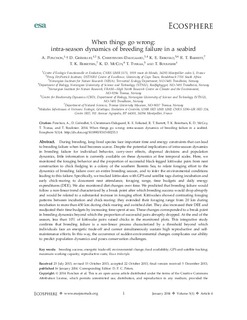| dc.contributor.author | Ponchon, Aurore | |
| dc.contributor.author | Grémillet, David J.H. | |
| dc.contributor.author | Christensen-Dalsgaard, Signe | |
| dc.contributor.author | Erikstad, Kjell E | |
| dc.contributor.author | Barrett, Robert T. | |
| dc.contributor.author | Reiertsen, Tone Kristin | |
| dc.contributor.author | McCoy, Karen D. | |
| dc.contributor.author | Tveraa, Torkild | |
| dc.contributor.author | Boulinier, Thierry | |
| dc.date.accessioned | 2017-12-20T08:33:28Z | |
| dc.date.available | 2017-12-20T08:33:28Z | |
| dc.date.created | 2014-01-21T14:29:56Z | |
| dc.date.issued | 2014 | |
| dc.identifier.citation | Ecosphere. 2014, 5 (1), 1-19. | nb_NO |
| dc.identifier.issn | 2150-8925 | |
| dc.identifier.uri | http://hdl.handle.net/11250/2473145 | |
| dc.description.abstract | During breeding, long-lived species face important time and energy constraints that can lead to breeding failure when food becomes scarce. Despite the potential implications of intra-season dynamics in breeding failure for individual behavior, carry-over effects, dispersal decisions and population dynamics, little information is currently available on these dynamics at fine temporal scales. Here, we monitored the foraging behavior and the proportion of successful black-legged kittiwake pairs from nest construction to chick fledging in a colony of the southern Barents Sea, to relate foraging effort to the dynamics of breeding failure over an entire breeding season, and to infer the environmental conditions leading to this failure. Specifically, we tracked kittiwakes with GPS and satellite tags during incubation and early chick-rearing to document nest attendance, foraging range, time budgets and daily energy expenditures (DEE). We also monitored diet changes over time. We predicted that breeding failure would follow a non-linear trend characterized by a break point after which breeding success would drop abruptly and would be related to a substantial increase in foraging effort. Kittiwakes showed contrasting foraging patterns between incubation and chick-rearing: they extended their foraging range from 20 km during incubation to more than 450 km during chick-rearing and switched diet. They also increased their DEE and readjusted their time budgets by increasing time spent at sea. These changes corresponded to a break point in breeding dynamics beyond which the proportion of successful pairs abruptly dropped. At the end of the season, less than 10% of kittiwake pairs raised chicks in the monitored plots. This integrative study confirms that breeding failure is a non-linear process characterized by a threshold beyond which individuals face an energetic trade-off and cannot simultaneously sustain high reproductive and selfmaintenance efforts. In this way, the occurrence of sudden environmental changes complicates our ability to predict population dynamics and poses conservation challenges. breeding success; energetic trade-off; environmental change; food availability; GPS and satellite tracking; maximum working capacity; reproductive costs; Rissa tridactyla. | nb_NO |
| dc.language.iso | eng | nb_NO |
| dc.publisher | Ecological Society of America | nb_NO |
| dc.rights | Navngivelse 4.0 Internasjonal | * |
| dc.rights.uri | http://creativecommons.org/licenses/by/4.0/deed.no | * |
| dc.title | When things go wrong: intra-season dynamics of breeding failure in a seabird | nb_NO |
| dc.type | Journal article | nb_NO |
| dc.type | Peer reviewed | nb_NO |
| dc.description.version | publishedVersion | nb_NO |
| dc.source.pagenumber | 1-19 | nb_NO |
| dc.source.volume | 5 | nb_NO |
| dc.source.journal | Ecosphere | nb_NO |
| dc.source.issue | 1 | nb_NO |
| dc.identifier.doi | 10.1890/ES13-00233.1 | |
| dc.identifier.cristin | 1096456 | |
| dc.relation.project | Norges forskningsråd: 193818 | nb_NO |
| dc.description.localcode | Copyright: © 2014 Ponchon et al. This is an open access article under the terms of the Creative Commons Attribution License, which permits use, distribution and reproduction in any medium, provided the original work is properly cited. | nb_NO |
| cristin.unitcode | 194,66,10,0 | |
| cristin.unitname | Institutt for biologi | |
| cristin.ispublished | true | |
| cristin.fulltext | original | |
| cristin.qualitycode | 1 | |

